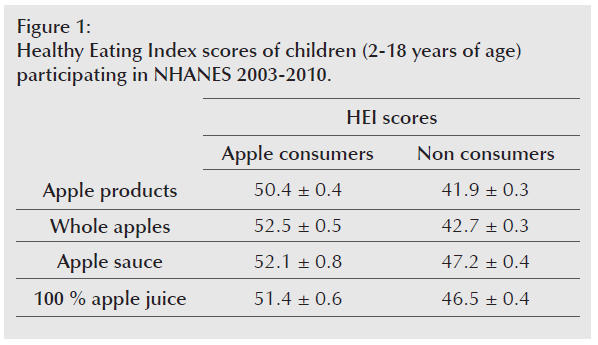Eating apples for a better diet quality and to reduce risk of obesity among children
Increasing intake of fruit would contribute to a healthy eating pattern. The recommendation for fruit depends on age, gender, and physical activity level; and varies from 1 cup equivalent for children 2-3 years of age (years) to 2 cups equivalents for males 14-18 years. Unfortunately, most children don’t meet the recommendation for fruit intake even if fruit consumption may prevent the risk of cardiovascular disease, type 2 diabetes, and some types of cancer.
Nutrient components of apples
Apples are the second most commonly consumed fruit in the United States, with 65% consumed as fresh fruit and 35% as processed apple products. Raw apples contain practically no total fat, saturated fatty acids, or sodium; and they have no cholesterol. One medium raw apple (182g) with its skin provides approximately 95 kcals, 19g total sugars, 4g dietary fiber (22% of the daily value [DV]) this makes apples an excellent source of fiber. They are also especially rich in phenolics like hydroxycinnamic acid derivatives and flavonoids.
Apple/apple product consumption assessment in the NHANES
The main aim of this study was to examine the link between diet, nutrition and health. In particular, it focused on the association between the consumption of apples, in its various forms, and diet quality. A sample of 13339 children (2-18 years) was asked to write down a 24-hour diet recall. The recall was framed by using the cycle appropriate United States Department of Agriculture (USDA) food codes (whole apples; apple sauce; 100% apple juice; total apples). The HEI-2010 allowed to determine diet quality and component scores. We considered 12 component scores, 9 measure adequacy, three moderation. In any case, the higher the scores, the better for our health.
Apple consumption in the study population
The results showed a correlation between apple consumption and some demographic characteristics. Mexican-Americans consumed more whole apples than apple sauce, while non-Hispanic blacks were less likely to consume whole apples and apple sauce.
Approximately 26% of the population (n = 3482) consumed apples in various forms including whole apples, which was the most consumed form (14%), and other apple products such as apple sauce (5%) and 100% apple juice (12%). Mean intake of any apple products was 222.2 ± 3.9 g with 143 ± 3.8 g from whole apple.
Apple consumption leads to higher HEI scores and lower prevalence of obesity
Consumers of any apple product had higher total HEI-2010 scores than non-consumers, even if these scores were relatively low (Figure 1).

Apple products and whole apple consumers had lower BMI z-scores than non-consumers (0.4 ± 0.04 v 0.5 ± 0.03 and 0.3 ± 0.1 v 0.5 ± 0.02, respectively) and had a lower prevalence of obesity. Only total apple product had a lower prevalence of overweight or obesity. No significant differences of weight or adiposity measures were found between apple sauce and apple juice consumers as compared with non-consumers. Finally, children who consumed total apple products (25%) and wholes apples (30%) were less likely to be obese than non-consumers.
Including apples in the children’s diet to meet the fruit recommendations
Total apple products and whole apples consumption should be encouraged as it contributes to the overall diet quality. This epidemiologic study is the first one, to our knowledge, that examined the association between apple products and weight. More research has to be conducted to explore the contribution of all fruit forms as a part of a healthy diet.
Based on: O’Neil CE, Nicklas TA, Fulgoni VL., III Consumption of apples is associated with a better diet quality and reduced risk of obesity in children: National Health
and Nutrition Examination Survey (NHANES) 2003–2010. Nutr J. 2015; 14:48
